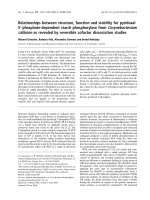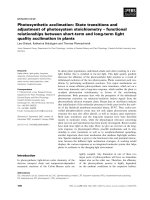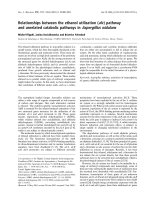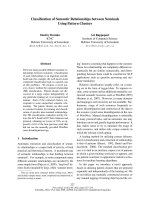Relationships Between Ideas
Bạn đang xem bản rút gọn của tài liệu. Xem và tải ngay bản đầy đủ của tài liệu tại đây (209.7 KB, 14 trang )
Relationships
Between Ideas
14
14.1 PARALLELISM
• Memorize It
14.2 JOINING IDEAS
• Either/Neither/Too
• Using Correlative Conjunctions
• Same/Different
• Connecting Ideas
• Pantomime
• Combinations
• Complete the Sentence
• Just Because
• Otherwise ...Or Else
269
14.1 PARALLELISM
1. MEMORIZE IT
Materials:
Worksheet 88
Dynamic:
Whole class
Time:
10 minutes
Procedure:
1. Make copies of the handout. Give half of your class Part A and the
other half, Part B. Do not tell the students that there is a
difference between the sentences in the two parts.
2. Tell the students to memorize the sentences for about 30 seconds
and then turn over their papers. On the backs of their papers, or
on another piece of paper, have them write the sentences exactly
as they remember them.
3. Students now turn their papers back to the front and check their
answers with the sentences. Did anyone get all the sentences
correct?
4. Reveal that there is a difference between the sentences in the two
parts and have a student with Part A compare papers with a
student who has part B. Ask them which one was easier to
remember and why. Talk about where the parallel structure is in
each sentence in Part A.
NOTE: Those students with Part A usually have an easier time
memorizing the sentences because of the parallel structure.
Occasionally, however, you may have a student who can memorize
Part B completely. In that case, talk about how some people have a
good ability to memorize, but that it is easier for most of us if there
is some kind of structure.
14.2 JOINING IDEAS
1.
EITHER
/
NEITHER
/
TOO
Materials:
3”x5” index cards
Dynamic:
Whole class
Time:
15 minutes
Procedure:
1. Write out two kinds of cards: one set has sentences; the other set
has short answers that agree or disagree. Each sentence in Set
One has only one matching answer in Set Two.
Example: Set One Set Two
I’m having a good time I am, too.
I’m not having fun. I’m not either.
The U.S. president lives in
Washington, D.C. His wife does, too.
I don’t have a headache. Neither do I.
I didn’t do the homework. Neither did I.
You’re a good student. You are, too.
2. Divide the students into two groups. Each student receives one
card. The students circulate and look for their match. They can say
their sentences to each opposite group member until they find the
appropriate matching answer.
3. Students can then invent their own sentences and see if their
classmates can give an appropriate answer.
2. USING CORRELATIVE CONJUNCTIONS
Materials:
Worksheet 89
Dynamic:
Pairs
Time:
15 minutes
Procedure:
1. Put students into pairs. Fill the blanks in the worksheet with your
students’ names. Give one copy of the worksheet to each pair of
students.
2. Have the pairs work together to write one sentence, joining the
pairs of sentences on the paper with an appropriate correlative
conjunction (both ...and, not only ...but also, either ...or, and
neither ...nor).
270
271
Example:
Guillermo has black hair. Jorge has black hair.
Possible combinations:
Both Guillermo and Jorge have black hair.
Not only Guillermo but also Jorge has black hair.
Variation:
Use the worksheet as a model only. Write your own sentences
containing information about students in your class. This will make it
seem less like an exercise and more fun for your students.
3. SAME / DIFFERENT
Materials:
Worksheet 90
Dynamic:
Pairs
Time:
20 minutes
Procedure:
1. Put students into pairs and give each student a copy of the
worksheet. The students ask each other the questions on the
worksheet. Then they write a sentence, using an appropriate
correlative conjunction to compare themselves with each student
who answered each question.
Example:
Question: What month were you born in?
Student A’s answer: June
Student B writes: Both
Student A and I were born in
June.
or Neither
Student A nor I was born in
September.
2. Circulate to check on student progress. When all pairs have
finished, you may want to have volunteers give a few example
sentences.
4. CONNECTING IDEAS
Materials:
Board, paper
Dynamic:
Small groups
Time:
10 minutes
Procedure:
1. Write a list of connecting words on the board (for example,
because, although, for, before, so). You may want to concentrate on
just one type (conjunctions, adverbial subordinators, or transitions)
or mix them.
2. Divide the class into groups of approximately three or four. Set a
time limit (perhaps 5 minutes), and have the groups write a logical
and grammatical sentence for each word on the board. Each
sentence must have a different meaning. (This avoids such
sentences as I went to bed after I finished my homework, I went to
bed before I finished my homework, I went to bed because I finished
my homework.)
3. For each word on the board, have the groups read their sentences.
Give the groups a point if a sentence is both grammatical and
logical. (If it is not correct, have other students correct it.) If you
are also looking for correct punctuation, have a student from each
group write some of the group’s answers on the board.
NOTE: The time limit will vary depending on the level of the class
and the number of words you list on the board. If you want, you
can give the class a topic to base their sentences on, although this
can lead to similar sentences, as noted in step 2 above.
5. PANTOMIME
Materials:
3”x5” cards with instructions on them
Dynamic:
Whole class
Time:
15 minutes
Procedure:
1. Write one situation on each card.
Suggestions: starting a car on a cold morning
receiving a letter from a good friend
eating something you don’t like
making scrambled eggs
trying to study next to a noisy person
Hand out cards, face down, to the most outgoing students, who will
be your “actors.” They should not show their cards to anyone.
2. Be sure the class understands the meaning of “pantomime.” Then
call the first student to the front of the class to act out his/her
card.
3. Ask the class to explain what the “actor” did by using adverbials of
time and sequence and adverbial clauses of time.
Example: “First, she sat down at the table. Then she took her
books out of her bag. As soon as she began to study,
another student sat down next to her.”
4. Encourage students to shout out possibilities for each action. Do
not focus on guessing what the “actor” was doing, but rather on
describing how he/she did it.
272









